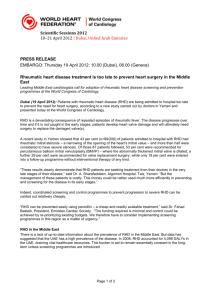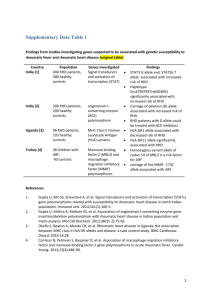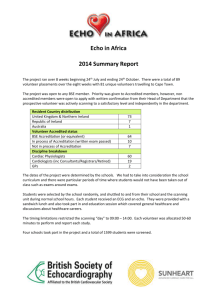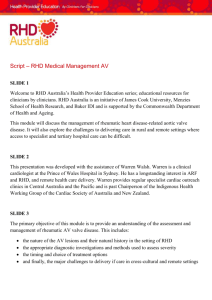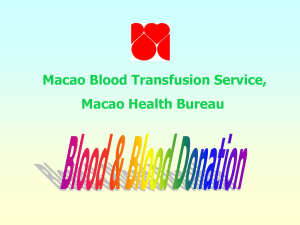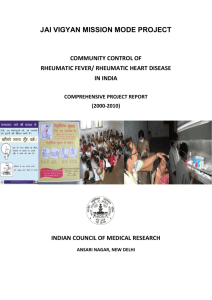Rheumatic Heart Disease Questionnaire
advertisement
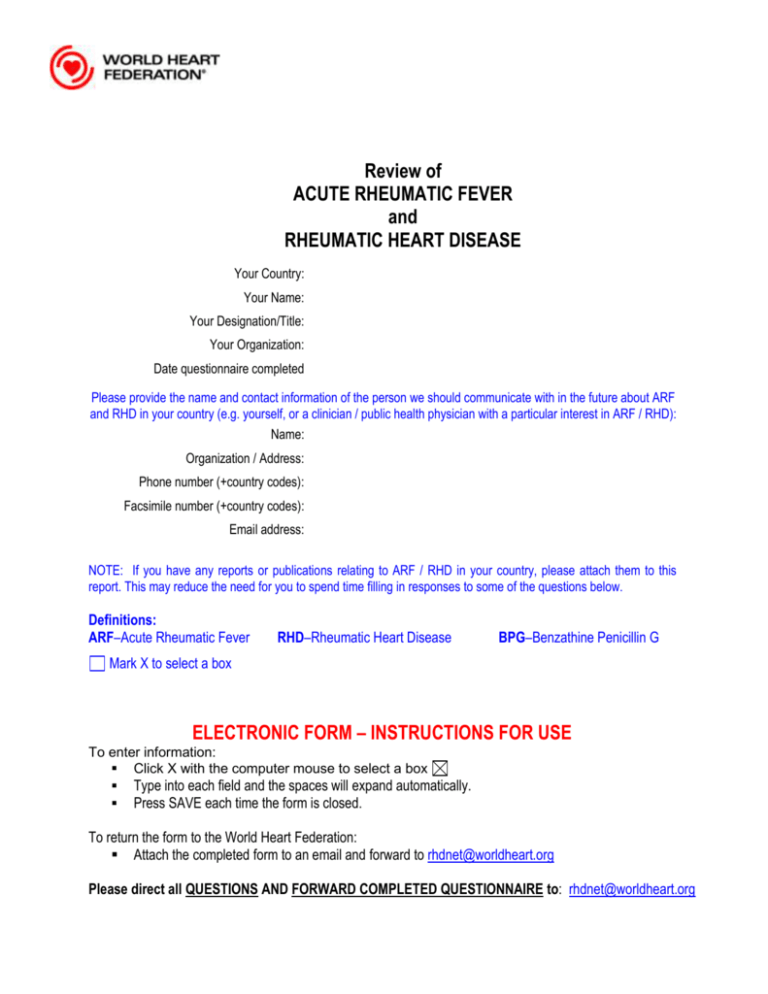
Review of ACUTE RHEUMATIC FEVER and RHEUMATIC HEART DISEASE Your Country: Your Name: Your Designation/Title: Your Organization: Date questionnaire completed Please provide the name and contact information of the person we should communicate with in the future about ARF and RHD in your country (e.g. yourself, or a clinician / public health physician with a particular interest in ARF / RHD): Name: Organization / Address: Phone number (+country codes): Facsimile number (+country codes): Email address: NOTE: If you have any reports or publications relating to ARF / RHD in your country, please attach them to this report. This may reduce the need for you to spend time filling in responses to some of the questions below. Definitions: ARF–Acute Rheumatic Fever RHD–Rheumatic Heart Disease BPG–Benzathine Penicillin G Mark X to select a box ELECTRONIC FORM – INSTRUCTIONS FOR USE To enter information: Click X with the computer mouse to select a box Type into each field and the spaces will expand automatically. Press SAVE each time the form is closed. To return the form to the World Heart Federation: Attach the completed form to an email and forward to rhdnet@worldheart.org Please direct all QUESTIONS AND FORWARD COMPLETED QUESTIONNAIRE to: rhdnet@worldheart.org RHEUMATIC HEART DISEASE CONTROL PROGRAM Please X all the following that you currently have in place in your country: A funded program to control RHD supported by a Government or private organisation A program to control RHD which is no longer funded or operational A list of known ARF/RHD patients on computer other (e.g. book or paper list) Diagnosis and treatment guidelines for health staff regarding ARF RHD An established process for identifying people with ARF (e.g. from hospital inpatients / outpatients department, paediatric clinic, schools) An established process for searching for people with RHD (e.g. antenatal clinic, school / community screening) Statistics or reports on local ARF and RHD published unpublished A nurse or doctor whose work is dedicated to ARF and RHD patients A group of local people interested in improving the control of RHD (e.g. RHD advisory group) Regular medical follow-up for ARF and RHD patients through primary health care services Established use of Penicillin to treat streptococcal infections (primary prophylaxis) Established, regular use of Penicillin to prevent recurrent ARF (secondary prophylaxis) A record of the number of BPG injections received by patients each year (i.e. compliance) Written information available to patients and the community regarding RHD valve surgery services available in-country abroad only ARF RHD both Echocardiography services Review of ACUTE RHEUMATIC FEVER and RHEUMATIC HEART DISEASE -2- PLEASE MAKES NOTES (include documents & reports where possible) RHD Programme (Staffing and responsibilities, centralized or decentralized care system) Funding (current or previous funding, source of funding, what is funded) Data management (type and quality of register / information systems, data sources, statistical reporting) Secondary prophylaxis (protocols, availability of medication, follow-up for people who default treatment,) Surgery (restrictions for RHD patients, issues with post-operative management) Review of ACUTE RHEUMATIC FEVER and RHEUMATIC HEART DISEASE -3- EPIDEMIOLOGY (Please provide any statistics, reports or other information you have on the following) Streptococcal pharyngitis (Strep Throat) Report Period for this information is (e.g. 1990-2000) This information is collected from single health facility multiple health facilities a) Average number of cases treated each year: national information system and population denominator: , or b) Incidence in children aged 5-14 years: c) Reference of any Streptococcal pharyngitis surveillance / projects undertaken in your country: or Streptococcal pharyngitis information unknown / not available Acute Rheumatic Fever (acute illness) Report Period for this ARF information is (e.g. 1990-2000) This information is collected from single health facility multiple health facilities national information system **** New Case = person who develops ARF for the first time Age at Diagnosis Average new cases diagnosed / year OR total new cases in (enter year) OR new case incidence figures Population figures OR recurrent case incidence figures Population figures (where these cases reported from) 5-14 years 15 – 34 years 35 years and older **** Recurrent Case = ARF in a person who has had ARF or RHD previously Age at Diagnosis Average recurrent cases diagnosed / year OR recurrent cases in (enter year) (where these cases reported from) 5-14 years 15 – 34 years 35 years and older or ARF information unknown / not available Rheumatic Heart Disease * Please enter the total number of live persons living with RHD The date/year that these cases were counted (e.g. 2005, Dec 2007) This information is collected from Age of persons now single health facility multiple health facilities Country or regional Data Hospital data only Total No. live cases* Total No. live cases* national information system Age 5-14 years Review of ACUTE RHEUMATIC FEVER and RHEUMATIC HEART DISEASE -4- Population figures (where these cases reported from) 15 years and older or RHD information unknown / not available Cardiac Surgery (to repair or replace heart valves) Report period for this information (e.g. 1990 to 2000): This information is collected from single health facility multiple health facilities national information system a) Average number of operations done on RHD patients per year: b) Current number of live post-surgical patients: c) Number of patients currently on the surgery waiting list: Please state where surgery is currently done, the approximate number of cases and the cost for one operation: Surgery done in your country: Surgery done in other countries: Do you have visiting surgical teams Yes No If yes, how often do they visit? Where do they come from? How are they funded? or Surgery information unknown / not available Secondary Prophylaxis Please record the number of people currently receiving secondary prophylaxis This information is collected from single health facility multiple health facilities a) Total number of people receiving 3 or 4 weekly BPG injections: national information system Compliance: Compliance = the total number of injections given divided by the number of injections planned for all people over the most recent full year on treatment. b) Total number of people receiving twice daily Penicillin tablets: c) Total number of people receiving twice daily Erythromycin tablets: or Secondary prophylaxis information unknown / not available Deaths Please record the total number of deaths where ARF or RHD was an underlying cause of death Report Period for this information is (e.g. 1990-2000) This information is collected from single health facility multiple health facilities national information system a) Total No. of deaths recorded: b) Average age at death for this group: Review of ACUTE RHEUMATIC FEVER and RHEUMATIC HEART DISEASE -5- c) Most common causes of death in this group: or Death information unknown / not available Estimated national annual cost of ARF and RHD (including cost of hospital admissions, echocardiography, secondary prophylaxis, staff salaries etc): Overall, do you believe the amount of RHD seen in your country over the last 10 years is: Decreasing No change Increasing (please X only one) No information / don’t know Briefly explain why you think this is so: Review of ACUTE RHEUMATIC FEVER and RHEUMATIC HEART DISEASE -6- SERVICE PROVISION ‘Rural areas’ here include areas where people live in small numbers (remote villages or small communities) What percent (%) of your country’s population lives in rural areas? % For this question, access to medical services includes reliable and affordable access for the rural population to facilities such as hospitals, echocardiography and cardiology services, and surgery as required (this may include remote specialist visits): Rural areas have Full access Partial access Poor access No access …….. to these services Please include some information about health services to rural areas here: What do you believe are your country’s greatest strengths that help with managing RHD? Local commitment of resources Medical / nursing expertise Early diagnosis / case detection / screening Secondary prophylaxis delivery Surgery services / referral Community awareness and participation Other / comments: What do you believe are your country’s main challenges with controlling RHD? Lack of material & financial support Lack of medical / nursing expertise Poor access to patients/ case finding Lack of awareness in the community Delayed diagnosis of ARF and/or RHD Compliance with secondary prophylaxis & medical review Limited access to tertiary services (including surgery) Poor data management / information systems Interrupted drug (Benzathine penicillin) supplies Other / comments: What could realistically happen in your country over the next 1-2 years to help improve (or continue to improve) control of RHD? Thank you for your interest and participation. Reviewed and Updated March 2008 ©2007 World Heart Federation Review of ACUTE RHEUMATIC FEVER and RHEUMATIC HEART DISEASE -7-
